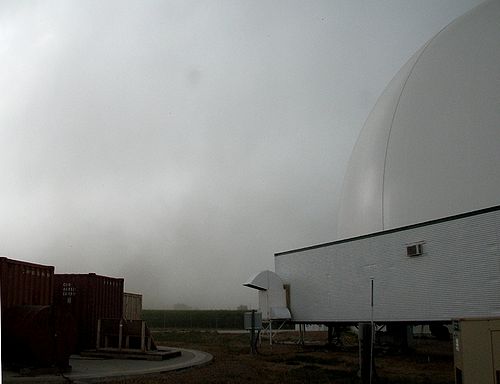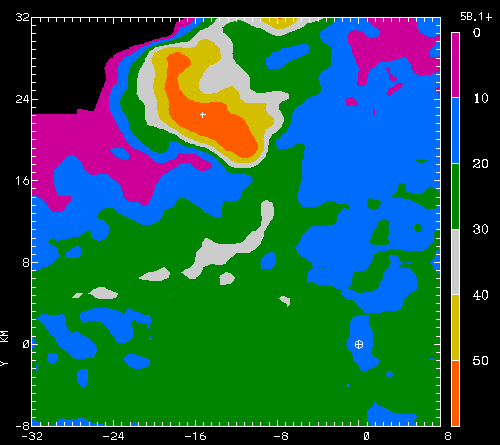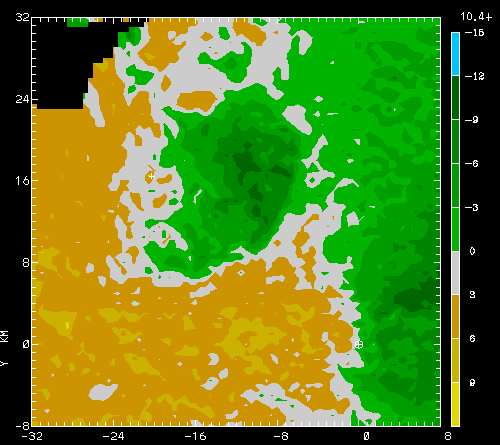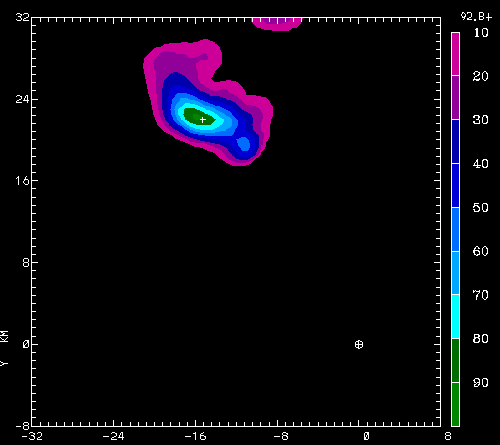Evolution of radial velocity and rain rate fields in low elevation PPI sweeps of a thunderstorm: 30 July 2010: Difference between revisions
Pat kennedy (talk | contribs) No edit summary |
Pat kennedy (talk | contribs) No edit summary |
||
| Line 4: | Line 4: | ||
==Reflectivity (dBZ)== | ==Reflectivity (dBZ)== | ||
The following series of images were generated using the NCAR SPRINT program to interpolate 1.5 degree elevation angle PPI data to a set of Cartesian gridpoints with spacings of 500m in the X and Y directions. (In the vertical direction, these gridpoints remained on the 1.5 degree elevation PPI surface). The images are at time intervals of slightly more than 4 minutes, during an overall time period of approximately 41 minutes. With time, stronger reflectivity levels appear in the southern portion of the echo core. A separate line of enhanced reflectivities associate with a gust front can be seen advancing ahead of the storm. | |||
<center> | <center> | ||
<imgloop delay=400 imgprefix="http://www.chill.colostate.edu/anim/30jul2010_rain_outflow/" width=500 height=445> | <imgloop delay=400 imgprefix="http://www.chill.colostate.edu/anim/30jul2010_rain_outflow/" width=500 height=445> | ||
| Line 21: | Line 22: | ||
==Radial Velocity (mps)== | ==Radial Velocity (mps)== | ||
A divergent radial velocity pattern becomes increasingly evident in association with the appearance of the stronger reflectivities towards the end of the loop. At the time of the next to the last frame (number 10 / 2126:01 UTC), the convergent air flow associated with the gust front causes negative (inbound) radial velocities to almost entirely surround the radar site. | |||
<center> | <center> | ||
<imgloop delay=400 imgprefix="http://www.chill.colostate.edu/anim/30jul2010_rain_outflow/" width=500 height=445> | <imgloop delay=400 imgprefix="http://www.chill.colostate.edu/anim/30jul2010_rain_outflow/" width=500 height=445> | ||
| Line 38: | Line 40: | ||
==Rain Rate (mm/hr)== | ==Rain Rate (mm/hr)== | ||
Instantaneous rain rates were computed from the reflectivity, differential reflectivity and specific propagation differential phase data using the CSU HIDRO methods described in Cifelli et al (JTEC 2010). Rain rates in excess of 150 mm / hr appear as the strong, microburst-scale outflow develops at 2113:33 UTC (frame 11). | |||
<center> | <center> | ||
<imgloop delay=400 imgprefix="http://www.chill.colostate.edu/anim/30jul2010_rain_outflow/" width=500 height=445> | <imgloop delay=400 imgprefix="http://www.chill.colostate.edu/anim/30jul2010_rain_outflow/" width=500 height=445> | ||
Revision as of 11:03, 22 May 2011
Introduction
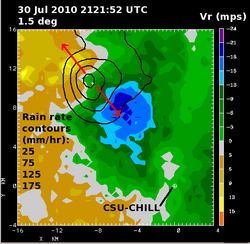
Reflectivity (dBZ)
The following series of images were generated using the NCAR SPRINT program to interpolate 1.5 degree elevation angle PPI data to a set of Cartesian gridpoints with spacings of 500m in the X and Y directions. (In the vertical direction, these gridpoints remained on the 1.5 degree elevation PPI surface). The images are at time intervals of slightly more than 4 minutes, during an overall time period of approximately 41 minutes. With time, stronger reflectivity levels appear in the southern portion of the echo core. A separate line of enhanced reflectivities associate with a gust front can be seen advancing ahead of the storm.
|
|
||
|
Radial Velocity (mps)
A divergent radial velocity pattern becomes increasingly evident in association with the appearance of the stronger reflectivities towards the end of the loop. At the time of the next to the last frame (number 10 / 2126:01 UTC), the convergent air flow associated with the gust front causes negative (inbound) radial velocities to almost entirely surround the radar site.
|
|
||
|
Rain Rate (mm/hr)
Instantaneous rain rates were computed from the reflectivity, differential reflectivity and specific propagation differential phase data using the CSU HIDRO methods described in Cifelli et al (JTEC 2010). Rain rates in excess of 150 mm / hr appear as the strong, microburst-scale outflow develops at 2113:33 UTC (frame 11).
|
|
||
|
